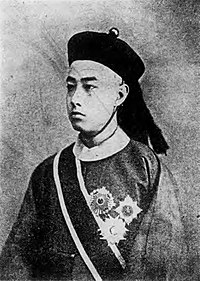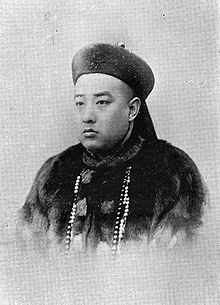Zaizhen
| Zaizhen | |||||||||
|---|---|---|---|---|---|---|---|---|---|
| Prince Qing of the First Rank | |||||||||
 Zaizhen | |||||||||
| Prince Qing of the First Rank | |||||||||
| Tenure | 1917–1947 | ||||||||
| Predecessor | Yikuang | ||||||||
| Born | 31 March 1876 Beijing, Qing Empire | ||||||||
| Died | 31 December 1947 (aged 71) Tianjin, Republic of China | ||||||||
| Spouse | Lady Socoro | ||||||||
| Issue | Puzhong Purui Pujun Pugang | ||||||||
| |||||||||
| House | Aisin Gioro | ||||||||
| Father | Yikuang | ||||||||
| Mother | Lady Hegiya | ||||||||
| Military career | |||||||||
| Allegiance | |||||||||
| Awards | Order of the Paulownia Flowers | ||||||||
| Zaizhen | |||||||||
|---|---|---|---|---|---|---|---|---|---|
| Traditional Chinese | |||||||||
| Simplified Chinese | 载振 | ||||||||
| |||||||||
| Yuzhou (courtesy name) | |||||||||
| Chinese | |||||||||
| |||||||||
| Prince Qing | |||||||||
| Traditional Chinese | |||||||||
| Simplified Chinese | 庆亲 | ||||||||
| |||||||||
Zaizhen (31 March 1876 – 31 December 1947), courtesy name Yuzhou, was a Manchu prince and politician of the late Qing dynasty. Romanised forms of his name include Tsai-chen, Tsai-Chen, Tsai-Cheng.
Life and service under the Qing dynasty[edit]

Zaizhen was born in the Aisin Gioro clan as the eldest son of Yikuang during the reign of the Guangxu Emperor. His family was from the Bordered Blue Banner of the Eight Banners. In 1894, Zaizhen was awarded the title of a second class zhenguo jiangjun. Seven years later, he was promoted to beizi.
In 1902, Zaizhen represented the Qing Empire on a diplomatic trip to Great Britain to witness the coronation of King Edward VII. He also visited France, Belgium, Japan and the United States. In 1903, he travelled to Japan to attend the fifth Kangyō Exhibition (
In 1906, after the Qing government introduced some reforms, Zaizhen, then 30 years old, was appointed as shangshu (
In 1911, Zaizhen was appointed as a guwen dachen (
Life after the Qing dynasty[edit]
Zaizhen fled to Shanghai when the Xinhai Revolution, which overthrew the Qing dynasty, broke out in October 1911. He returned to Beijing later. In 1917, after Yikuang's death, Zaizhen inherited his father's princely title, "Prince Qing of the First Rank". He was granted permission to do so by Li Yuanhong, the President of the Republic of China.
In 1924, after Puyi, the Last Emperor who had abdicated in 1912, was forced out of the Forbidden City by the Beiyang Government, Zaizhen feared that he would be implicated so he fled to Shanghai and took shelter in the British concession there. During his time in Shanghai, he invested in various businesses and stayed out of politics.
Zaizhen died in Shanghai in 1947. Cao Rulin, Zhu Zuozhou and others proposed to the Nationalist Government to award Zaizhen the posthumous name zhen (
Family[edit]
Parents
- Father: Yikuang, posthumously known as "Prince Qingmi of the First Rank"
- Mother: Secondary Consort, of the Hegiya clan (
大 側 福 晉 合 佳 氏 )
Consort and issue
- Primary Consort, of the Socoro clan (嫡福
晉 索 綽羅氏 )- Puzhong (溥鐘; b. 1898 - d. ?), married a daughter of Grand Secretary (
大 學士 ) Natong (那 桐 )., first son - Purui (溥銳; b. 1899 - d. ? ), married another of Natong's daughters, second son
- Pujun (溥鈞), married a woman of the Erdet (鄂爾
德 特 ) clan who was a daughter of Duangong (端 恭 ) and younger sister of Wenxiu, third son
- Puzhong (溥鐘; b. 1898 - d. ?), married a daughter of Grand Secretary (
- Secondary Consort, of the Fuca clan (侧福
晋 富 察氏)- Pugang (溥钢, b. 1928- d. ?), fourth son
- Secondary Consort, of the Konggiya clan (
側 福 晉 孔 佳 氏 ) - Secondary Consort, of the Migiya clan (
側 福 晉 米 佳 氏 ) - Secondary Consort, of the Ninggiya clan (
福 晉 甯佳氏 )
See also[edit]
References[edit]
- ^ Portraits on Chinese banknotes (1): Zaizhen (Tsai Chen).https://chinesemoneymatters.wordpress.com/2017/05/05/portraits-on-chinese-banknotes-1-zaizhen-tsai-chen/
- ^ See the gifts from China in the Royal Collection.https://www.royalcollection.org.uk/search/site/tsai-chen
- Zhao, Erxun (1928). Draft History of Qing (Qing Shi Gao). Vol. 221. China.
{{cite book}}: CS1 maint: location missing publisher (link)
